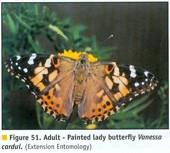
Thistle Caterpillar (Painted Lady) Vanessa cardui (Linnaeus)
Description: The body of the adult is about 1 inch long with a wingspan of about 2 inches. The upper wing surfaces are brown with red and orange mottling and white and black spots. Each hind wing has a row of four distinct and obscure eyespots. Eggs are small, spherical and white. The larvae are brown to black and spiny, with a pale yellow stripe on each side. Mature larvae are 1.25 to 1.5 inches long.
|